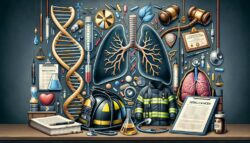Ferodo
Ferodo is an esteemed brand within the automotive industry, primarily recognized for its manufacturing of premium brake components. Since its establishment in 1897, Ferodo has built a reputation for innovation and quality in the realm of friction products. The company offers a comprehensive range of braking materials, including pads, shoes, discs, and fluids, catering to a diverse array of vehicles and driving conditions. With a commitment to safety and performance, Ferodo ensures that its products adhere to strict quality standards. However, the brand's history is also marked by its former use of asbestos, which has had lasting implications for worker health and safety. Today, Ferodo continues to focus on sustainable practices and technological advancements to maintain its legacy as a trusted name in the automotive aftermarket.

Key Takeaways
- Ferodo was the first company to use asbestos in brake linings, which endangered the lives of factory workers and mechanics.
- Former Ferodo employees are now struggling with asbestos-related diseases such as lung cancer and mesothelioma.
- Individuals who developed lung cancer, mesothelioma, and other cancers due to occupational asbestos exposure are eligible for compensation.
- Asbestos fibers can contaminate the environment and lead to secondary exposure for family members, emphasizing the need for close monitoring of their health.
Ferodo’s Asbestos Legacy
In light of its historical use of asbestos, Ferodo's legacy is now marred by the serious health consequences faced by its workers and their families. Despite the known risks, appropriate asbestos regulations were not always adhered to, compromising worker safety. The latency period of asbestos-related diseases means that diagnoses and symptoms can emerge decades after initial exposure. The burden of corporate accountability weighs heavily on Ferodo, as it grapples with the legal and moral implications of its past manufacturing practices. Precision in the application of health and safety standards could have mitigated the current plight of affected individuals. Today, the company's responsibility extends to ensuring rigorous enforcement of asbestos regulations to prevent further harm and to provide redress to those already impacted.
Asbestos Health Risks
How does asbestos exposure pose health risks to individuals involved in the manufacturing and handling of brake components? Asbestos fibers, when inhaled, can become trapped in the lung tissue causing scarring and inflammation. Over time, this can lead to severe, long term health effects including:
- Asbestosis, a chronic lung disease causing shortness of breath and increased risk of lung infections.
- Mesothelioma, a rare and aggressive cancer that primarily affects the lining of the lungs and the abdomen.
- Lung cancer, especially prevalent among smokers who are also exposed to asbestos.
Compliance with asbestos regulations is critical in mitigating these risks. Despite advancements in occupational health standards, the legacy of asbestos exposure in industries like brake manufacturing continues to present serious health challenges.
Worker Safety Failures
The failure of Ferodo to provide adequate safety measures for its workers handling asbestos-laden brake components represents a significant lapse in occupational health responsibilities. This neglect has had dire consequences, as asbestos exposure is known to result in severe, often fatal respiratory diseases. Despite the known risks, Ferodo did not implement the necessary worker protection measures or prioritize improving safety measures, which could have mitigated the harm to their employees.
| Year | Incident | Impact |
|---|---|---|
| 1970s | Inadequate PPE | Chronic Illness |
| 1980s | No dust control | Mesothelioma Diagnoses |
| 1990s | Poor ventilation | Increased Cancer Risk |
| 2000s+ | Legacy of Exposure | Ongoing Health Crises |
These technical oversights in industrial hygiene practices underscore the importance of regulatory compliance and proactive risk management in manufacturing environments.
Diseases From Asbestos
Why should concerns about asbestos exposure be taken seriously when considering the serious diseases it can cause, such as lung cancer and mesothelioma? The inhalation of asbestos fibers can lead to chronic respiratory conditions and malignancies that manifest after prolonged latency periods, often several decades post-exposure. The gravity of these conditions necessitates a rigorous approach to monitoring and litigation.
- Lung Cancer: Prolonged asbestos exposure significantly increases the risk of developing lung carcinoma.
- Mesothelioma: An aggressive cancer that affects the lining of the lungs, heart, or abdomen, almost exclusively linked to asbestos exposure.
- Asbestosis: A progressive, non-malignant fibrotic disease of the lungs.
Asbestos-related lawsuits are pivotal in addressing the long-term health consequences faced by individuals exposed to this hazardous material, securing compensation and justice for affected workers and their families.
Former Employee Struggles
Numerous former Ferodo employees are now grappling with severe health issues as a direct consequence of their asbestos exposure during their tenure at the company. The material, once integral to the manufacturing of friction products, has left a legacy of long-term health effects, including debilitating respiratory conditions and malignancies such as mesothelioma and lung cancer. Former employee support mechanisms are critical in addressing these delayed disease manifestations, which often surface decades post-exposure. As occupational safety regulations evolve, the emphasis shifts to proactive monitoring and comprehensive support for affected individuals. These developments underscore the importance of rigorous health surveillance and specialized care to mitigate the impact of past occupational hazards on the lives of former Ferodo employees.
Future Health Concerns
As we examine the long-term implications of asbestos exposure for former Ferodo employees, it becomes clear that ongoing health surveillance is essential to identify and manage future health concerns related to this hazardous material. Not only do these concerns pertain to direct health effects, but also the broader impact on the environment which can perpetuate exposure risks.
Key aspects of future health surveillance include:
- Systematic Monitoring: Establishing a routine health monitoring protocol to detect early signs of asbestos-related diseases.
- Environmental Assessments: Regularly evaluating the residual asbestos impact on the environment to mitigate further exposure.
- Preventive Measures: Implementing preventive healthcare measures to reduce the progression of any asbestos-related conditions.
Addressing these elements technically and with precision will be crucial for safeguarding affected individuals and communities.
At-Risk Occupations
Within the automotive industry, occupations such as factory workers and mechanics are particularly vulnerable to asbestos exposure due to historical use of the material in brake linings by companies like Ferodo. These occupational hazards are amplified by the latency period of asbestos-related diseases, often resulting in diagnoses decades after exposure. With asbestos fibers being both inhalable and friable, workplace safety protocols historically lacked stringent measures to protect against airborne contaminants. Consequently, the onus of mitigating health risks fell inadequately on the individual workers. Modern occupational health directives mandate rigorous controls and personal protective equipment to shield workers from such insidious risks. However, for those previously employed in environments contaminated by asbestos, ongoing health monitoring remains a critical component of occupational safety and personal well-being.
Importance of Health Checks
Regular health screenings are vital for factory workers' and mechanics' early detection of asbestos-related diseases, given their history of exposure to hazardous materials like those once used by Ferodo. The importance of regular health checks cannot be overstated, as they play a crucial role in:
- Identifying signs of asbestos-related conditions before symptoms become severe
- Monitoring the health status of individuals who have been exposed to asbestos
- Preventing the impact of asbestos on family members through early detection and intervention
Technical advancements in medical diagnostics have significantly improved the detection of asbestos-related diseases. Regular, detailed health assessments are essential for at-risk populations, not only for their well-being but also for the timely initiation of appropriate medical and legal responses to occupational hazards.
Claim Eligibility Criteria
Individuals who have developed serious health conditions such as lung cancer or mesothelioma due to occupational asbestos exposure at Ferodo are entitled to pursue compensation through legal claims. To initiate the claim process, claimants must satisfy specific medical and legal criteria, substantiating their diagnosis with comprehensive medical documentation and evidence of employment history with Ferodo. The compensation options available may include settlements or awards that cover medical expenses, lost income, and punitive damages, where applicable. It is imperative for claimants to engage with attorneys versed in asbestos litigation to navigate the complex legal framework effectively. The onus to illustrate a direct correlation between the occupational exposure at Ferodo and the resultant health condition rests with the claimant and their legal representation.
Legal Support for Families
How can families of Ferodo workers affected by asbestos-related diseases secure legal support to pursue compensation claims? To navigate the complexities of such cases, it is imperative for families to enlist specialized legal counsel. Lawyers with expertise in asbestos litigation can provide comprehensive guidance to maximize the prospects of obtaining legal compensation. This entails a meticulous evaluation of medical records to substantiate the link between asbestos exposure at Ferodo and the resultant health condition.
- Securing expert legal representation experienced in asbestos litigation
- Conducting thorough analysis of medical documentation to establish causation
- Accessing medical support resources to bolster the compensation claim
An authoritative legal team will meticulously manage the claim, ensuring that families receive the necessary support and advocacy to address the significant medical and financial repercussions associated with asbestos-induced illnesses.
Misdiagnosis Challenges
Misdiagnosis of asbestos-related diseases presents a significant obstacle for former Ferodo employees and their families seeking justice and compensation. Elevated misdiagnosis rates are attributable to the clinical complexity of asbestos-related conditions, which can mimic less serious respiratory diseases or other types of cancer, leading to medical mismanagement. The latency period of these diseases, extending up to several decades, compounds the challenge, as initial symptoms are often subtle and nonspecific. Consequently, misdiagnosis can result in inappropriate treatment protocols, further endangering patient health and delaying rightful compensation claims. It is imperative that medical professionals maintain a high index of suspicion and employ comprehensive diagnostic criteria when evaluating individuals with a history of asbestos exposure, to minimize the incidence of misdiagnosis and ensure accurate, timely therapeutic interventions.
Secondary Exposure Risks
Asbestos fibers, inadvertently carried home on the clothing and skin of Ferodo workers, posed a significant risk of secondary exposure to their families. The introduction of asbestos in homes through this vector has both health and legal implications, including the potential for family members to develop asbestos-related illnesses without having directly handled the material themselves.
- Contamination Pathways: Clothing, tools, and even vehicles can serve as carriers for asbestos fibers into domestic environments.
- Health Consequences: Secondary exposure can lead to conditions such as mesothelioma, underlining the importance of medical vigilance for families of exposed workers.
- Legal Recourse: Those affected by secondary exposure have grounds for seeking compensation, necessitating a thorough understanding of legal avenues and precedents.
Monitoring Family Health
In light of secondary asbestos exposure risks associated with Ferodo workers, it is imperative for their family members to undergo regular health screenings for early detection of asbestos-related diseases. Initiating a robust family health monitoring protocol is critical for these individuals. This protocol should include periodic medical examinations with a focus on respiratory health, employing both imaging technology and pulmonary function tests. Prevention measures must also be emphasized, encompassing environmental assessments of living spaces to ensure the eradication of any lingering asbestos fibers. It is essential that healthcare providers are informed of the potential for secondary exposure, enabling them to apply a high index of suspicion and thereby facilitate prompt intervention. Effective monitoring and preventative strategies are paramount in mitigating the long-term health impacts on these families.
Asbestos Wrongful Death
Family members facing the devastating consequences of a loved one's wrongful death due to asbestos exposure at Ferodo can seek legal recourse to obtain justice and compensation. The path to securing asbestos compensation involves navigating complex legal frameworks that demand a high level of technical expertise and knowledge of historical occupational safety standards. Legal professionals specializing in asbestos-related litigation are equipped to enforce legal accountability against corporate negligence.
- Statute of Limitations: Understanding the time constraints for filing a wrongful death lawsuit is crucial.
- Proof of Exposure: Compiling a detailed work history with Ferodo to establish the source of asbestos exposure.
- Compensation Claims: Identifying and calculating potential damages, including loss of income, medical expenses, and pain and suffering.
Securing a favorable outcome requires meticulous case construction and unwavering advocacy for the rights of the bereaved.
Ferodo Product Range
Ferodo's extensive product line encompasses a variety of brake components, including pads, shoes, discs, and fluids, catering to diverse automotive needs. Ferodo product innovations have consistently set industry benchmarks, integrating advanced material compounds and precision engineering to enhance performance and safety. The advantages of Ferodo brake pads are particularly noteworthy; engineered for optimal friction dynamics, they offer superior stopping power, reduced stopping distances, and exceptional durability under varying conditions. These brake pads feature unique blends of friction materials tailored to specific vehicle requirements, ensuring compatibility and reliability. Furthermore, Ferodo's commitment to rigorous testing guarantees each product exceeds stringent safety standards, providing drivers with confidence and peace of mind.
Frequently Asked Questions
How Has Ferodo’s Corporate Image and Reputation Been Affected by Its Historical Use of Asbestos?
The asbestos legacy severely tarnishes a corporation's image, necessitating comprehensive image rehabilitation efforts. Such historical use of hazardous materials undermines public trust and requires transparent, sustained initiatives to restore credibility. An affected entity must demonstrate a commitment to safety, environmental responsibility, and rigorous health standards. Strategic communication, coupled with genuine corporate responsibility actions, is vital to mitigating the long-term reputational damage caused by associations with asbestos.
What Steps Has Ferodo Taken in Recent Years to Address the Environmental Concerns Associated With Brake Component Manufacturing?
In a Herculean effort to redeem industrial processes, companies are implementing Green Initiatives and Manufacturing Innovations to mitigate environmental impact. Striving for ecological harmony, advancements include the adoption of sustainable materials, energy-efficient production methods, and waste-reduction strategies. These technical transformations are pivotal, as they signify an authoritative shift towards responsible stewardship of environmental resources, ensuring manufacturing sustains both the quality of its products and the health of our planet.
Does Ferodo Offer Any Community Support or Health Programs for Areas Where Their Factories Are or Were Once Located?
In the domain of corporate social responsibility, it is imperative for enterprises to deploy community engagement strategies and health initiatives, especially in locales proximate to their operational sites. These programs typically encompass educational outreach, healthcare services, and environmental stewardship efforts. They serve to fortify the relationship between the corporation and the local populace, addressing public health concerns and enhancing the overall well-being of the community.
How Does Ferodo Ensure the Ethical Sourcing of Materials Used in Their Current Brake Products?
How can a company ensure the ethical procurement of its materials? In the case of brake product manufacturing, rigorous material tracing protocols are essential. By conducting thorough supplier audits, a manufacturer can monitor its supply chain for compliance with ethical standards. An authoritative approach involves detailed scrutiny of each step in the procurement process, ensuring that materials are sourced responsibly and sustainably, aligning with industry best practices and technical precision.
What Advancements in Brake Technology Is Ferodo Currently Developing to Stay Ahead in the Automotive Industry?
In the automotive industry, advancements in brake technology are pivotal for safety and performance. Current development focuses on brake customization options catering to diverse vehicle specifications and driving conditions. Performance testing is also crucial, ensuring reliability under various stress scenarios. These improvements enhance vehicle control and driver confidence, a testament to the technical prowess and forward-thinking approach necessary to lead in a competitive market.

This post has been generated by AI and was not reviewed by editors. This is Not legal advice. Please consult with an attorney.




